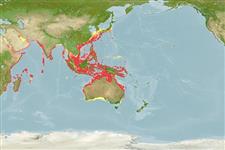Environment: milieu / climate zone / depth range / distribution range
Écologie
marin benthopélagique; profondeur 30 - 110 m (Ref. 9688). Tropical; 37°N - 43°S, 33°E - 157°E (Ref. 6181)
Indo-West Pacific: Red Sea, Mozambique Channel, Saya de Malha Bank, Chagos Islands, Andaman Sea, northern and southeastern Australia, South China Sea, East China Sea, Tasman Sea, Philippines, and southern Japan.
Taille / Poids / Âge
Maturity: Lm ? range ? - ? cm
Max length : 90.0 cm TL mâle / non sexé; (Ref. 6181); common length : 50.0 cm TL mâle / non sexé; (Ref. 6181)
Épines dorsales (Total): 5; Rayons mous dorsaux (Total): 126-144; Épines anales 2; Rayons mous anaux: 47 - 50. Body extremely elongate, compressed and tapering to a point. Pelvic fins reduced to scale-like processes; caudal fin absent. Lateral line running almost straight mid laterally nearer the ventral than the dorsal contour. Color is silvery white becoming silvery gray with dark cloud-like patches after death.
Benthopelagic or pelagic in coastal waters but not found where there is low salinity. Feeds mainly on small fishes, squids and crustaceans. Caught mainly with bottom trawls and sometimes with bag nets, mixed with other trichiurid fishes in southeast Asian countries. Marketed fresh and dried salted in the Philippines.
Life cycle and mating behavior
Maturité | Reproduction | Frai | Œufs | Fécondité | Larves
Nakamura, I. and N.V. Parin, 1993. FAO Species Catalogue. Vol. 15. Snake mackerels and cutlassfishes of the world (families Gempylidae and Trichiuridae). An annotated and illustrated catalogue of the snake mackerels, snoeks, escolars, gemfishes, sackfishes, domine, oilfish, cutlassfishes,. scabbardfishes, hairtails, and frostfishes known to date. FAO Fish. Synop. 125(15):136 p. (Ref. 6181)
Statut dans la liste rouge de l'IUCN (Ref. 130435)
Menace pour l'homme
Harmless
Utilisations par l'homme
Pêcheries: intérêt commercial mineur
Plus d'informations
Noms communsSynonymesMétabolismePrédateursÉcotoxicologieReproductionMaturitéFraiRassemblement de ponteFéconditéŒufsDéveloppement de l'œuf
RéférencesAquacultureProfil d'aquacultureSouchesGénétiqueElectrophoresesHéritabilitéPathologiesTraitementNutrientsMass conversion
CollaborateursImagesStamps, Coins Misc.SonsCiguateraVitesseType de nageSurface branchialeOtolithesCerveauxVision
Outils
Articles particuliers
Télécharger en XML
Sources Internet
Estimates based on models
Preferred temperature (Ref.
123201): 22.5 - 28.3, mean 27.2 °C (based on 500 cells).
Phylogenetic diversity index (Ref.
82804): PD
50 = 1.0000 [Uniqueness, from 0.5 = low to 2.0 = high].
Bayesian length-weight: a=0.00191 (0.00078 - 0.00466), b=3.11 (2.90 - 3.32), in cm total length, based on LWR estimates for this (Sub)family-body shape (Ref.
93245).
Niveau trophique (Ref.
69278): 4.2 ±0.58 se; based on food items.
Generation time: 3.8 ( na - na) years. Estimated as median ln(3)/K based on 1
growth studies.
Résilience (Ref.
120179): Milieu, temps minimum de doublement de population : 1,4 à 4,4 années (Preliminary K or Fecundity.).
Fishing Vulnerability (Ref.
59153): Moderate vulnerability (38 of 100).
